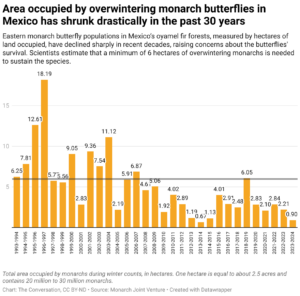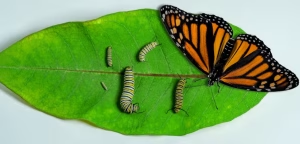By William E. Snyder, University of Georgia, and Michael Crossley, University of Delaware
Monarch butterflies are among the most beloved insects in North America. They are brightly colored and unique, both as caterpillars and later as mature insects. Monarchs are found in every U.S. state except Alaska, so nearly everyone has seen a monarch flutter by on a warm day.
During their incredible yearly migration, monarchs travel each fall to a few forested areas in central Mexico and coastal California to overwinter. These are special places, cool enough that butterflies don’t burn too much energy, but warm enough that they don’t freeze. At the sites, huge clusters of butterflies drape the trees in one of nature’s most photogenic spectacles.
Over the past 40 years, the number of monarchs overwintering in Mexico has declined by as much as 80%, and the number of monarchs overwintering in California has fallen by over 95%, probably due to multiple causes. In response, the U.S. Fish & Wildlife Service is proposing to protect monarchs as a threatened species under the Endangered Species Act. The agency is soliciting public comments on this proposal through March 12, 2025.
We are among the many entomologists who study the ecology of insects, including monarchs; our focus has been on the butterflies’ recent health and how their numbers are changing through time. In our view, some parts of the actions that have been proposed to reverse their decline are likely to be helpful. Other aspects, however, might only make the situation worse.
Fewer monarchs overwintering
Listing a species as threatened under the Endangered Species Act means that it is nearing, but does not yet face, imminent extinction. The main basis for the proposal to list monarchs as threatened is that researchers are seeing fewer of the butterflies each year at their overwintering sites.

There’s little debate that the monarch’s epic yearly migration is in trouble. Analyses of fall-migrating monarchs collected through the Journey North program, in which citizen scientists report the number and location of large groups of monarchs resting in trees at night during their southward trip, show that the number of monarchs traveling to Mexico fell by 80% or more between 2007 and 2023.
It is not clear why monarchs are failing to migrate, but there are several possible culprits. They are vulnerable to a single-celled parasite called Ophryocystis elektroscirrha, or OE, which can cause wing deformation, reduced size, decreased flight endurance and impaired mating. Infection rates in monarchs have dramatically increased in recent years.
Studies have also found that large numbers of migrating monarchs are killed by cars. Climate change is altering weather patterns during the monarch breeding season, producing weather extremes that can kill traveling monarchs or put them out of sync with the flowers they need to survive. Finally, with warmer weather, some monarchs are simply staying put year-round without migrating.
Yet there is growing evidence that monarchs are doing fine in the summer throughout much of their breeding range, where they mate, lay eggs and grow the generation that will eventually head south in the fall. In a 2022 study, we analyzed counts of monarch butterflies during the North American Butterfly Association’s annual butterfly counts, when private citizens gather around the Fourth of July each year to record butterfly sightings all across North America. Surprisingly, we found no overall change in the number of monarchs over the past few decades.
Echoing our finding, other scientists conducted a genetic analysis in 2023 that also found no evidence of population decline in monarchs, or in common milkweed, the butterflies’ main larval host plant. They did this by comparing observed patterns of genetic variation with thousands of simulated datasets mimicking different scenarios of population growth or decline. In fact, clearing of forests for agriculture over past centuries appeared to have created more habitat for the plants and insects.
How can monarchs be doing so well in the summer but so poorly in the winter? We believe the likely answer is that monarchs have an incredible ability to rebound during the breeding season. Like many other insects, a single female monarch can lay hundreds of eggs. And because milkweed still is readily available, monarchs appear to be able to bounce back each year despite fewer numbers of overwintering butterflies.
This would explain why observers still see monarchs each summer in every state of the continental U.S. Such a broad distribution is very different from an endangered species such as the black-footed ferret, which is found in only a few isolated locations.
Options for restoration
When a species is added to the Endangered Species List, federal regulators develop a recovery plan – effectively, a road map for recovery. It may include steps such as conserving and restoring habitat that the species uses, removing invasive species that prey on it, or breeding the threatened species in captivity and releasing it into the wild.

(NCTC Creative Imagery/USFWS/Flickr)
We see the Interior Department’s proposed steps to help monarchs as a mixed bag.
Usefully, the listing would legally protect the groves of trees near the California coast where western monarchs overwinter. The eastern monarch population’s overwintering grounds in Mexico are already protected, and it is a sensible step to take similar action in California.
Other aspects of the listing are more worrisome. The proposal notes that private citizens have a unique opportunity to help rescue a threatened species by raising butterflies – but this could be counterproductive.
One issue is that the most widely available milkweeds at local plant nurseries often are tropical milkweed (Asclepias curassavica) and other nonnative species. Many volunteers could plant these milkweeds, intending to help create habitat for monarchs. But these exotic versions don’t die back in the fall like native milkweeds, so their presence could confuse monarchs into thinking it’s not yet time to migrate. And these plants’ longer flowering times could allow OE parasite spores to build up on their leaves.
Captive-raising monarchs in cages also puts the butterflies at risk. The OE parasite can reach very high levels in indoor butterfly houses. And captive-raised butterflies often are too stunted to migrate, probably because they are weakened by heavy parasitic infections and questionable genetics.
Focus on migration routes and wintering zones
In our view, the most effective way to help monarchs would be to concentrate on the parts of their lives where the butterflies are clearly struggling: fall migration and overwintering. Conserving overwintering sites and planting appropriate types of flowering plants along fall migration routes can help more butterflies survive the journey. Private citizens can make valuable contributions to these efforts.
However, research suggests that planting milkweed in the monarchs’ summer range is not needed, and that captive rearing is likely to be harmful.
We agree with the U.S. Fish and Wildlife Service that monarchs have great value as conservation icons, and that they help build public interest in insects. Our concern is that the public could be encouraged to ignore scientific findings and take actions that may harm these incredible and inspiring insects.![]()
William E. Snyder is a professor of entomology at the University of Georgia and Michael Crossley is an assistant professor/agricultural entomologist at the University of Delaware.
This article is republished from The Conversation under a Creative Commons license. Read the original article. Banner photo: A monarch butterfly perched on a milkweed flower (iStock image).
Sign up for The Invading Sea newsletter by visiting here. To support The Invading Sea, click here to make a donation. If you are interested in submitting an opinion piece to The Invading Sea, email Editor Nathan Crabbe at ncrabbe@fau.edu.



